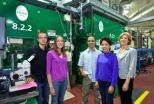(Press-News.org) Tuberculosis, or TB, is a dreaded contagious disease of the lungs and other organs. The causative agent, Mycobacterium tuberculosis (or M. tuberculosis), infects roughly a third of the world's population and one-in-ten to one-in-twenty of the infected population becomes sick or infectious at some point during their lifetime.
The mycobacteria survive, and even thrive, inside host macrophages – cells that are part of the human immune system and that usually engulf and destroy bacteria in structures called phagosomes. M. tuberculosis is taken into phagosomes but it somehow blocks phagosome maturation, and hence survives. Figuring out how could open up new therapeutic targets for the treatment of TB as well as shedding light on the mechanism of intracellular parasitism.
Researchers at the Pasteur Institutes in Seoul and Paris and Institute of Pharmacology and Structural Biology (IPBS) in Toulouse joined forces to systematically search for mycobacterial genes that block phagosome maturation. To do this, they generated 11,000 different mutants of the M. tuberculosis Beijing strain, which has been associated with large outbreaks of TB, increased virulence, and multidrug resistance.
Using a high-throughput visual assay, the researchers screened for mutant mycobacteria that had lost the ability to arrest phagosomal maturation. Lead author Dr. Priscille Brodin, heading the Inserm Avenir Unit at Institut Pasteur Korea describes the screen as "enabling stringent selection of mutants that have the most pronounced subcellular localization within intracellular acidic compartments through the use of automated confocal quantitative imaging. Our approach", she adds, "may be useful to identify virulence genes in other intracellular pathogens".
The team identified ten distinct mutants, only one of which had previously been shown to play a part in phagosome maturation arrest. Finding that two independent mutants mapped to the same region, they studied this locus in more detail. The work revealed that the biosynthesis of particular glycolipids containing acyltrehalose was perturbed, suggesting to the researchers that these glycolipids play a critical role in the early intracellular protection of mycobacteria.
"Our study unravels the role of novel lipid molecules in mycobacterial intracellular parasitism" says Dr. Olivier Neyrolles leading a CNRS Unit at IPBS in Toulouse France. "This establishes potential new drug targets", especially important given the emergence of multidrug-resistant and extensively drug-resistant TB. "In addition", Dr Brodin points out, "the assay that have we developed can be readily adapted for the screening of novel antimicrobials".
INFORMATION:
1. P. Brodin1, Y. Poquet et al., "High content phenotypic cell-based visual screen identifies Mycobacterium tuberculosis acyltrehalose-containing glycolipids involved in phagosome remodeling", PLoS Pathogens, finish reference…
How mycobacteria avoid destruction inside human cells
Newly published in PLoS Pathogens
2010-09-10
ELSE PRESS RELEASES FROM THIS DATE:
Renewable energy needs more community power
2010-09-10
An analysis of wind farm applications in England shows that rejection of wind energy projects is connected to areas with high political engagement and high life expectancy. The current trend shows that many technically suitable locations may remain unused because of the threat of effective local resistance by people who are relatively privileged.
Planning delays and rejections encourage commercial developers to instead focus on remote or deprived communities as sites for new power plants. In areas of economic fragility, commercial plants are more easily established without ...
European Union could create incentive for new drug treatments
2010-09-10
DURHAM, N.C. – Drug companies may be more willing to develop treatments for neglected diseases including malaria, tuberculosis and leishmanaiasis if the European Union would adopt a "priority review voucher" reward system.
The vouchers would give a company accelerated regulatory review of one of its other drugs as a reward for developing a treatment for a neglected disease.
Although these diseases affect more than 1 billion people, they occur most frequently in developing nations, providing little financial incentive for pharmaceutical companies to create and test new ...
Basic physical capability can predict mortality in later life
2010-09-10
People who are better at simple physical acts such as gripping, walking, rising from a chair and balancing on one leg are more likely to live longer, according to a new study published on bmj.com today.
Measures of physical capability, such as grip strength, walking speed, chair rising time and standing balance ability, can predict mortality in older people living in the community, UK researchers found.
These measures are related to a person's ability to perform everyday tasks. There is growing interest in using such measures as simple screening tools to identify ...
Diagnostic errors 'greatest threat to patient safety in hospitals,' claims senior doctor
2010-09-10
Diagnostic errors are the most important causes of avoidable harm to patients in hospitals, warns a senior doctor on bmj.com today.
Dr Gordon Caldwell, a consultant physician at Worthing Hospital in Western Sussex argues that doctors need better facilities and sufficient time to make a correct diagnosis.
When a patient is admitted to hospital, the team of doctors formulate a "working diagnosis," he explains. At this point, the diagnosis is uncertain but the patient is treated as if the working diagnosis is correct.
"If over the next few days the patient gets better, ...
CRISPR critters: Scientists identify key enzyme in microbial immune system
2010-09-10
Imagine a war in which you are vastly outnumbered by an enemy that is utterly relentless – attacking you is all it does. The intro to another Terminator movie? No, just another day for microbes such as bacteria and archaea, which face a never-ending onslaught from viruses and invading strands of nucleic acid known as plasmids. To survive this onslaught, microbes deploy a variety of defense mechanisms, including an adaptive-type nucleic acid-based immune system that revolves around a genetic element known as CRISPR, which stands for Clustered Regularly Interspaced Short ...
Inflicting greater harm judged to be less harmful
2010-09-10
Los Angeles, CA (September 7, 2010) – Joseph Stalin once claimed that a single death was a tragedy, but a million deaths was a statistic. New research from the Kellogg School of Management at Northwestern University validates this sentiment, confirming large-scale tragedies don't connect with people emotionally in the same way smaller tragedies do.
The new study, entitled "The Scope-Severity Paradox: Why doing more harm is judged to be less harmful," has been published in the current issue of Social Psychological and Personality Science (published by SAGE) and was conducted ...
Pediatric vaccine stockpile policies need to be revisited, researcher says
2010-09-10
CHAMPAIGN, Ill. — Vaccine manufacturers and public health decision-makers need to collaborate in a more efficient and effective manner not only to reduce the likelihood of supply shortages for pediatric vaccines but also to maximize community immunity by using vaccine doses to increase coverage, according to research published by a University of Illinois researcher who specializes in statistics and data analysis.
Sheldon H. Jacobson, a professor of computer science and the director of the simulation and optimization laboratory at Illinois, says that the Pediatric Vaccine ...
Scientists observe single ions moving through tiny carbon-nanotube channel
2010-09-10
CAMBRIDGE, Mass. — For the first time, a team of MIT chemical engineers has observed single ions marching through a tiny carbon-nanotube channel. Such channels could be used as extremely sensitive detectors or as part of a new water-desalination system. They could also allow scientists to study chemical reactions at the single-molecule level.
Carbon nanotubes — tiny, hollow cylinders whose walls are lattices of carbon atoms — are about 10,000 times thinner than a human hair. Since their discovery nearly 20 years ago, researchers have experimented with them as batteries, ...
Early cotton planting requires irrigation
2010-09-10
MADISON, WI, September 9, 2010 – Cotton growers can produce more cotton if they plant early, but not without irrigation. That's the finding of an article published in the September-October 2010 Agronomy Journal, a publication of the American Society of Agronomy.
Bill Pettigrew, a scientist with the USDA-Agricultural Research Service in Stoneville, Mississippi, tested the performance of cotton under irrigated and non-irrigated plots, with half the plots being planted early (first week of April) and half being planted in the more tradition time period, around the 1st week ...
Promising treatment for metastatic melanoma 'fast tracked' by FDA
2010-09-10
HACKENSACK, N.J. (September 9, 2010) — Researchers from the John Theurer Cancer Center at Hackensack University Medical Center played an important role in a study that led to the Food & Drug Administration's (FDA) recent fast tracking of ipilimumab, a promising treatment for metastatic melanoma. The FDA based its decision largely on the results of a pivotal study published in the New England Journal of Medicine on August 19, 2010 – the same day the agency accepted Bristol-Myers Squibb's application for the drug's approval and granted the application priority review status.
Ipilimumab ...
LAST 30 PRESS RELEASES:
Making lighter work of calculating fluid and heat flow
Normalizing blood sugar can halve heart attack risk
Lowering blood sugar cuts heart attack risk in people with prediabetes
Study links genetic variants to risk of blinding eye disease in premature infants
Non-opioid ‘pain sponge’ therapy halts cartilage degeneration and relieves chronic pain
AI can pick up cultural values by mimicking how kids learn
China’s ecological redlines offer fast track to 30 x 30 global conservation goal
Invisible indoor threats: emerging household contaminants and their growing risks to human health
Adding antibody treatment to chemo boosts outcomes for children with rare cancer
Germline pathogenic variants among women without a history of breast cancer
Tanning beds triple melanoma risk, potentially causing broad DNA damage
Unique bond identified as key to viral infection speed
Indoor tanning makes youthful skin much older on a genetic level
Mouse model sheds new light on the causes and potential solutions to human GI problems linked to muscular dystrophy
The Journal of Nuclear Medicine ahead-of-print tip sheet: December 12, 2025
Smarter tools for peering into the microscopic world
Applications open for funding to conduct research in the Kinsey Institute archives
Global measure underestimates the severity of food insecurity
Child survivors of critical illness are missing out on timely follow up care
Risk-based vs annual breast cancer screening / the WISDOM randomized clinical trial
University of Toronto launches Electric Vehicle Innovation Ontario to accelerate advanced EV technologies and build Canada’s innovation advantage
Early relapse predicts poor outcomes in aggressive blood cancer
American College of Lifestyle Medicine applauds two CMS models aligned with lifestyle medicine practice and reimbursement
Clinical trial finds cannabis use not a barrier to quitting nicotine vaping
Supplemental nutrition assistance program policies and food insecurity
Switching immune cells to “night mode” could limit damage after a heart attack, study suggests
URI-based Global RIghts Project report spotlights continued troubling trends in worldwide inhumane treatment
Neutrophils are less aggressive at night, explaining why nighttime heart attacks cause less damage than daytime events
Menopausal hormone therapy may not pose breast cancer risk for women with BRCA mutations
Mobile health tool may improve quality of life for adolescent and young adult breast cancer survivors
[Press-News.org] How mycobacteria avoid destruction inside human cellsNewly published in PLoS Pathogens

